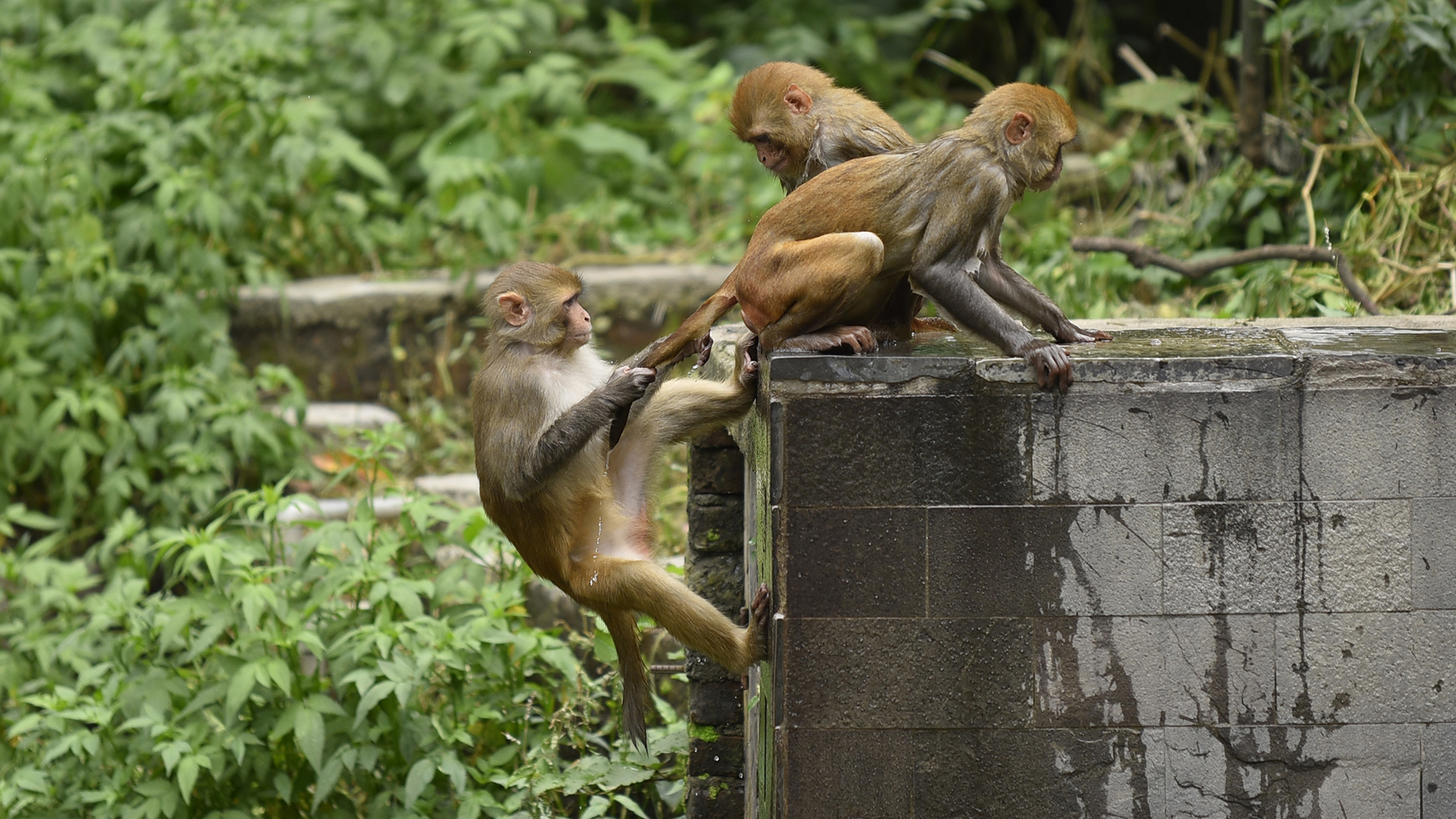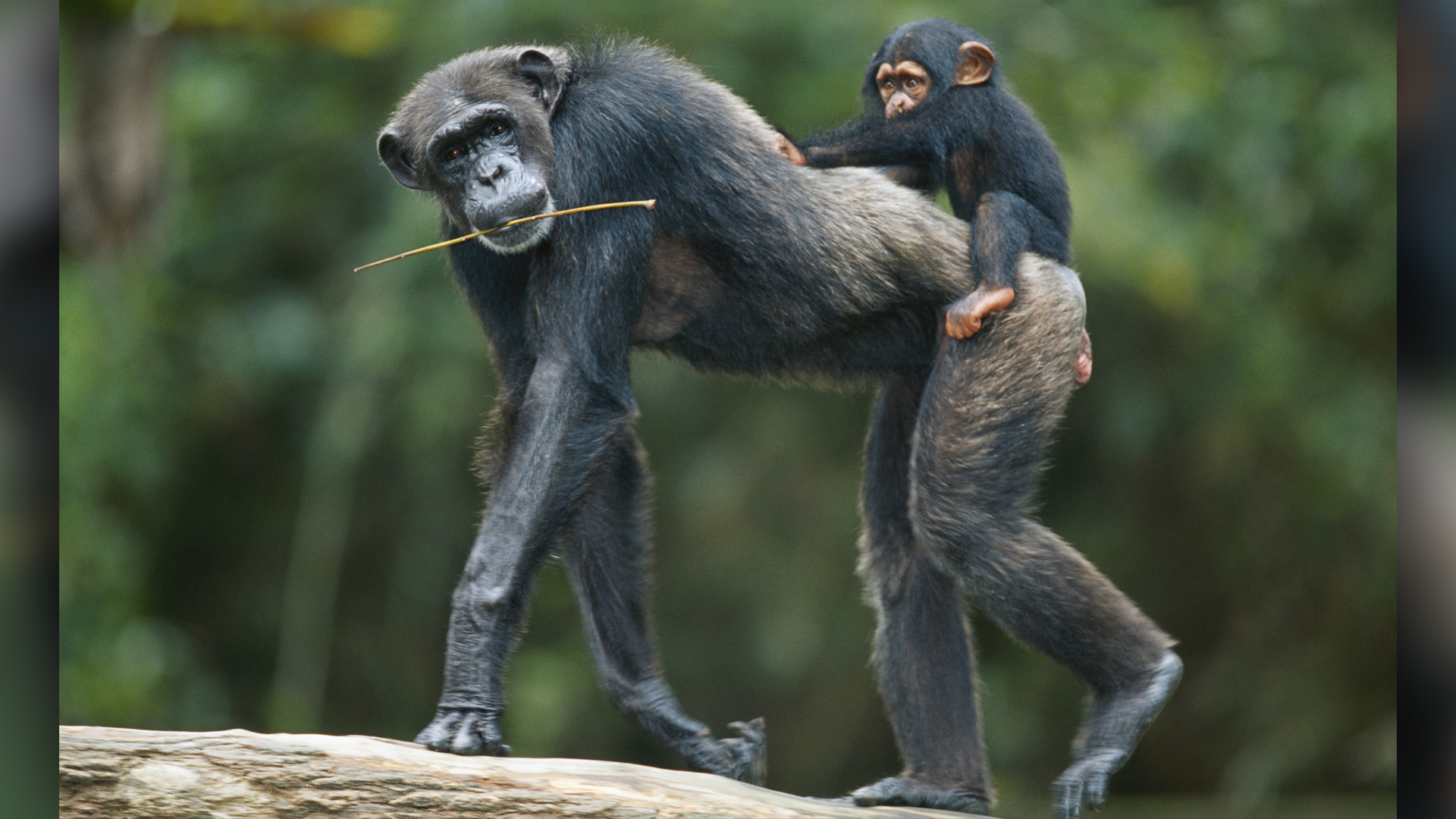Why don't people have tails?
Scientists recently found that a so-called jumping gene may have jumped ship millions of years ago, and taken our tails with it.
Tens of millions of years ago, the common ancestors of humans and all other primates had tails. Many modern primates, such as monkeys and lemurs, still have tails, but as primates diversified and evolved, the ancestors of modern humans, as well as apes such as chimps and bonobos — our closest primate relatives — ditched their tails entirely.
Why did some primates keep their tails, while humans and apes didn't? Tail loss is thought to be part of the backstory for humans evolving to be bipedal, but precisely how we lost our tails is a question that scientists have long sought to answer.
Recently, researchers uncovered a genetic clue about why humans have no tails. They identified a so-called jumping gene related to tail growth that may have leaped into a different location in the genome of a primate species millions of years ago. And in doing so, it created a mutation that took our tails away.
Related: Why haven't all primates evolved into humans?
As it happens, humans DO still have tails — when we're embryos. Tails are a trait that can be traced back to Earth's first vertebrates, so when human embryos develop, we briefly have tails — vertebrae included — during the earliest stages of our growth, as do all animals with backbones. But after about eight weeks, most embryonic human tails completely disappear. They are lost through a process known as apoptosis, a type of programmed cell death that's built into the development of multicellular life, scientists wrote in 2008 in the journal Nature.
After that, the only remnant of these lost tails in humans is about three or four vertebrae that form the coccyx, or tailbone.
Sometimes human babies are born with tails, though this is exceptionally rare. These vestigial protrusions are embryonic leftovers and are usually pseudo tails rather than "true tails," according to a study published in 2012 in the Journal of Indian Association of Pediatric Surgeons. Skin-covered pseudo tails contain muscle, nerves, blood vessels and connective tissue, but they lack bones and cartilage and are not connected to the spinal cord, as true tails would be.
Get the world’s most fascinating discoveries delivered straight to your inbox.
But how did humans become tailless? For Bo Xia, formerly a graduate student at New York University who is now a principal investigator at the Broad Institute, that conundrum has been a source of fascination since childhood, he told Live Science in an email. Xia is researching the genetic mechanisms of human development, disease and evolution. He is also the lead author of a study identifying a genetic "smoking gun" for how humans lost their tails.
The findings were first published in 2021 on the preprint server bioRxiv and were later released in the journal Nature, in February 2024.
"I wondered about it when I was a young kid, seeing [that] almost all kinds of animals have a tail — but not me," Xia said. Following a recent tailbone injury, Xia decided to investigate the seat of the problem more closely, to learn how evolution had stripped humans and apes of their tails.
The earliest known tailless ancestor of humans and apes is a primate genus called Proconsul, which lived in Africa during the Miocene epoch (23 million to 5.3 million years ago) and had no sign of caudal vertebrae — the bones found in tails. But tail loss is thought to have originated even earlier: about 25 million years ago, when the hominoid lineage of humans and apes diverged from Old World monkeys, Xia and his co-authors wrote in the study.
Related: Tale of 2 tails: Why do sharks and whales swim so differently?
They compared genetic data from six species of hominoids and nine species of monkeys, looking for differences that could be linked to the presence or absence of tails. One likely candidate emerged in a short piece of DNA called an Alu element — a type of DNA that can jump from one place in the genome to another and affects protein production — tucked away in the gene TBXT, which regulates tail development. This mutation was present in the genomes of apes and humans, but not in those of monkeys.
The researchers then used the gene-editing technology CRISPR to replicate this mutation in the TBXT gene in mice; the genetically modified animals sported tails that varied in length, from normal to no tails at all. While the mutation did affect their tails, it wasn't an on/off switch; this told the scientists that other genes in primates also played a part in our total taillessness.
However, the appearance of this mutation "was likely a critical event" in disrupting tail production, study senior co-author Itai Yanai, scientific director of the Applied Bioinformatics Laboratories at NYU Langone Health, told Science.
Tail ups and downs
Apes and early humans may have benefitted from losing their tails as it helped them transition to two-legged walking, an evolutionary development that coincided with being tail-free, the researchers reported.
But primates that kept their tails benefitted in other ways, as these appendages perform a variety of helpful functions, said Michelle Bezanson, a professor of anthropology at Santa Clara University's College of Arts and Sciences in California. Bezanson, whose research covers primate behavior and locomotion, was not involved in the new study.
"Tails may be extended during leaping and aid in orienting the body through the air and in preparation for landing," she told Live Science in an email. "They aid in balance/stabilization while moving, foraging and even sleeping," and can brace the body against a surface while the animal is hanging from its back legs, she added.
A primate's tail can sometimes also serve as a tool. For example, white-faced capuchins (Cebus capucinus) use their tails "to sop up water in a tree hole and then drink the water from the fur, almost like a sponge," Bezanson said. Primates may also snuggle up to their tails as pillows, huddle under them for warmth, or even use them during social behavior.
"One of my favorite things to observe is when a young monkey uses its prehensile tail to grasp onto their mother's body or her tail," Bezanson said. Monkeys may also tug on each others' tails during play, and South American titi monkeys in the Callicebus genus intertwine tails with their mates as a show of affection, Live Science previously reported.
With these myriad possibilities for tail tasks, it's almost enough to make a tailless human feel like they're missing out. Is there any chance that people could one day have tails again? Unfortunately, we lost our tails so long ago that regaining them is likely beyond our grasp, Xia said. Tail loss took place about 25 million years ago, long before our species, Homo sapiens, walked the Earth. Over the many millions of years that followed, the genetic playbook for tail development in our lineage ceased to function, and all the pieces that were required for tails to develop have long since been lost.
"Even if we correct the specific genetic mutation that we found in our manuscript, we still may not be able to re-develop such a structure," Xia said.
Editor's note: This story was updated on Feb. 28, 2024 to note Xia's change in affiliation and that his team's study had been published in Nature. The story was originally published Nov. 15, 2021.

Mindy Weisberger is a science journalist and author of "Rise of the Zombie Bugs: The Surprising Science of Parasitic Mind-Control" (Hopkins Press). She formerly edited for Scholastic and was a channel editor and senior writer for Live Science. She has reported on general science, covering climate change, paleontology, biology and space. Mindy studied film at Columbia University; prior to LS, she produced, wrote and directed media for the American Museum of Natural History in NYC. Her videos about dinosaurs, astrophysics, biodiversity and evolution appear in museums and science centers worldwide, earning awards such as the CINE Golden Eagle and the Communicator Award of Excellence. Her writing has also appeared in Scientific American, The Washington Post, How It Works Magazine and CNN.






